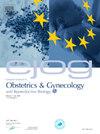Trigonometric characteristics of episiotomy & pregnancy variables
IF 1.7
Q3 OBSTETRICS & GYNECOLOGY
European Journal of Obstetrics and Gynecology and Reproductive Biology: X
Pub Date : 2025-07-05
DOI:10.1016/j.eurox.2025.100418
引用次数: 0
Abstract
Introduction
Episiotomy, though simple and most common surgical procedure performed in labour theatre, has a lot of bearing on patients’ recovery postpartum. The episiotomy angle and length can influence probability of anal sphincter trauma, ease of delivery and post-delivery recovery in variable ways. We hypothesize that a universal measure of angle (60°) and length might not be ideal for all women. This aim of this cohort study was to establish association of episiotomy trigonometric characteristics (length and angle) with antepartum, intrapartum and postpartum factors.
Material & methods
A total of 504 pregnant women who delivered with an episiotomy after 34 weeks of gestation were included. Antenatal, intrapartum, and postpartum variables were collated. These women were examined for episiotomy length, angle, signs of infection/inflammation and pain using Visual Analogue Scale (VAS). All of them were followed up till they were discharged frm the hospital.
Results
A smaller episiotomy angle (<15°) was associated with significantly higher VAS score as compared to angle 35°-40°. We observed that as birth weight increases, mean episiotomy length and angle progressively increases. Longer head circumference was associated with longer length of episiotomies (p < 0.01). Instrumental deliveries were associated with higher length and angle of episiotomy.
Conclusion
We observed a relationship of trigonometric characteristics of episiotomy with variables like birth weight and HC. We feel the angle and length of episiotomy cannot be defined as a universal constant. It depends of maternal and fetal variables. We propose that episiotomy should be tailored for every patient to achieve the most optimal result for her.
Synopsis
This study reflects episiotomy practice at a tertiary care hospital. We must conduct larger studies to evaluate variables that influence the trigonometric characteristics of episiotomy.
会阴切开术与妊娠变量的三角函数特征
会阴切开术是产房最常用的简单手术,但对患者的产后恢复有很大的影响。会阴切开术的角度和长度对肛门括约肌损伤的概率、分娩难易程度和产后恢复有不同的影响。我们假设,一个通用的角度(60°)和长度测量可能并不适合所有女性。本队列研究的目的是建立会阴切开术三角特征(长度和角度)与产前、产时和产后因素的关系。材料,方法对妊娠34周后行外阴切开术分娩的孕妇504例进行分析。整理了产前、产时和产后的变量。使用视觉模拟评分(VAS)检查这些妇女的会阴切开术长度、角度、感染/炎症迹象和疼痛。对他们所有人进行了随访,直到他们出院。结果与35°~ 40°角度相比,较小的会阴切开角度(15°)VAS评分明显较高。我们观察到随着出生体重的增加,平均会阴切开长度和角度逐渐增加。较长的头围与较长的会阴切开术长度相关(p <; 0.01)。器械分娩与会阴切开术的长度和角度有关。结论观察了会阴切开术的三角函数特征与出生体重、HC等变量的关系。我们认为,会阴切开术的角度和长度不能被定义为一个普遍的常数。这取决于母体和胎儿的变量。我们建议,外阴切开术应该为每个病人量身定制,以达到最理想的结果。本研究反映了一家三级医院会阴切开术的实践。我们必须进行更大规模的研究来评估影响会阴切开术三角特征的变量。
本文章由计算机程序翻译,如有差异,请以英文原文为准。
求助全文
约1分钟内获得全文
求助全文
来源期刊

European Journal of Obstetrics and Gynecology and Reproductive Biology: X
Medicine-Obstetrics and Gynecology
CiteScore
2.20
自引率
0.00%
发文量
31
审稿时长
58 days
 求助内容:
求助内容: 应助结果提醒方式:
应助结果提醒方式:


